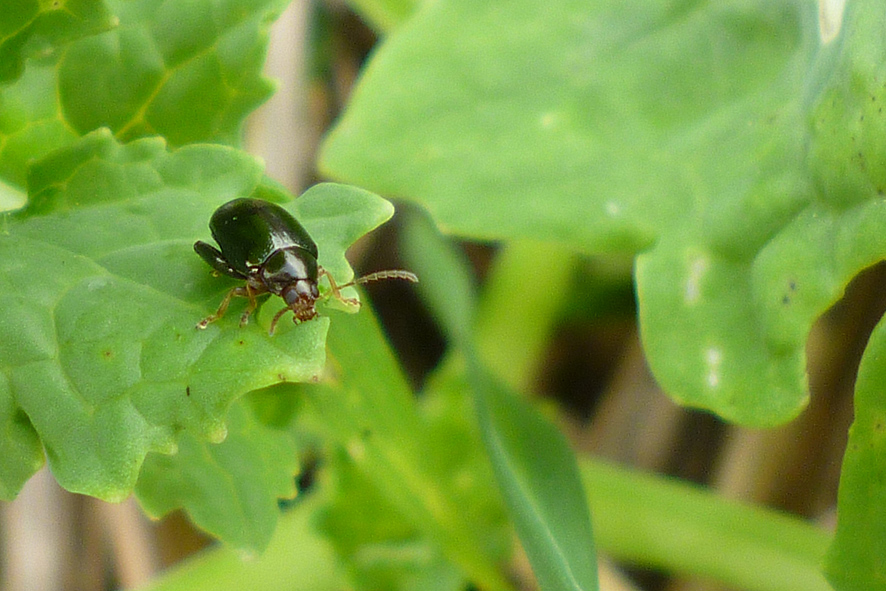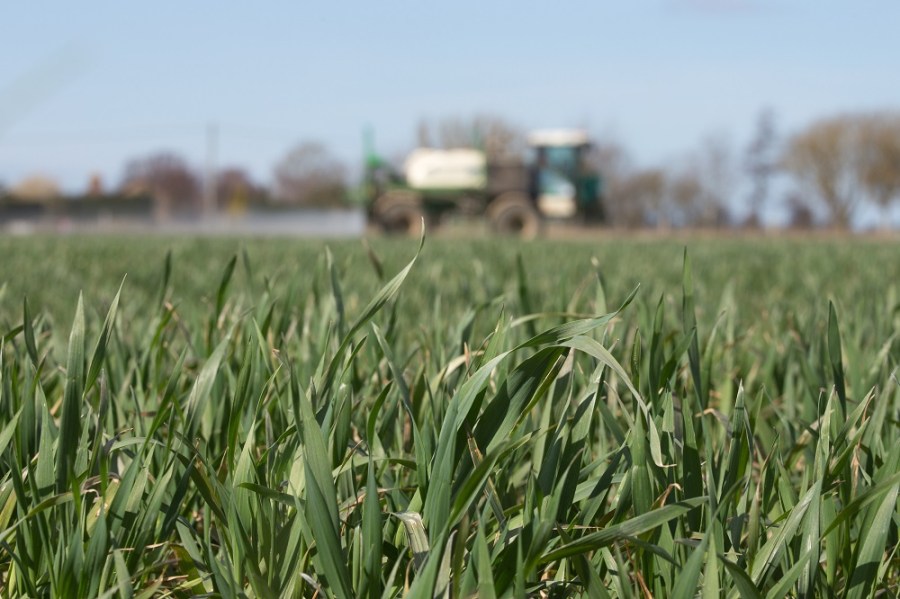There were no new products but plenty of new ideas for some of arable farming’s biggest challenges from scientists who gathered in Brighton to present recent research. CPM joined them to gain an insight.
Resistance is a one-way ticket with no returns available.
By Tom Allen-Stevens
The solutions for some of arable farmers’ biggest problems may be the tools that already lie in their hands. The question is how best to use them, rather than what they are.
Control of cabbage stem flea beetle (CSFB), aphids and grassweeds were recurrent themes of the Association of Applied Biologists’ (AAB) Crop Protection in Southern Britain Conference, that took place in Brighton in Nov. Papers presented addressed the difficulties of doing so following the loss of neonicotinoids and rising resistance issues.
Neonics, where used, no longer provide adequate protection for oilseed rape, noted NIAB’s Simon Kightley. “We’ve lost the battle against CSFB and no seed dressing will get it back.”
His comments are based on the results of a crowdsourcing survey carried out during autumn in 2015-2017. Growers and agronomists were asked, via an app, to give the location and severity of crop damage. The survey showed up mid-Aug as the best time to establish an OSR crop to avoid severe CSFB infestations, with damage increasing from later sowings. Feedback from those growers who used neonic seed dressings via the Defra derogation of 2015 reveals the treatment did little to alleviate the high pressure from the pest the crops were under.
Three years of companion-cropping trials, to find a suitable mix that will help protect a crop from beetle grazing damage, have shown that white mustard has the greatest potential. “But yield suppression from inter-plant competition in late autumn is a problem, and early removal of the companion crop is therefore required.”
Clearfield OSR may provide the answer, with the herbicide Cleravo (imazamox+ quinmerac) taking out the companion plants. “Further work is needed to decide optimal seed rates and timing for the eventual destruction of the mustard,” added Simon.
Don’t spray off your OSR volunteers too early, advised Dr Sacha White of ADAS – they could lure CSFB away from your newly-established crop. These were the preliminary findings of field-scale trials carried out under high CSFB pressure in Cambs. “Trap crops have been shown to reduce CSFB infestations, but drilling them is costly and they require careful management. So we looked at the potential for delaying control of volunteers in a nearby field coming out of OSR.”

OSR volunteers lure CSFB away from your newly-established crop.
The work has focused on two farms, looking at pairs of fields where one is coming out of OSR (exOSR) and the crop being established in the other (new OSR). Beetle numbers and damage were assessed in each case, with two pairs of fields identified on each farm. In some pairs, the exOSR volunteers were controlled in early/mid Aug, while in the rest, the volunteers were left until mid Sept, by which time the new OSR crop had established.
“On one site, however, only a quarter of the exOSR volunteers were left for the late treatment, while on the other the whole exOSR field was left,” noted Sacha.
The results showed clear benefits for CSFB pressure from delaying control of volunteers until mid Sept at the earliest in a nearby field coming out of OSR. “Numbers of adult CSFB were consistently lower, plant populations higher and feeding damage lower. What’s more, the effect persists until several weeks after the volunteers had been controlled.
“Previous work has shown a biological quirk of CSFB adults whose wing muscles are thought to waste away once they’ve settled in a crop. That may be what’s happened here. We are repeating these trials this year. If effective this would also be a means of breaking the life cycle of the pest, as any eggs and larvae in the OSR volunteers would die when the volunteers are controlled.
“We are repeating these trials this year. If effective this would also be a means of breaking the life cycle of the pest, as any eggs and larvae in the OSR volunteers would die when the volunteers are controlled.”
But on the site where only a quarter of the volunteers were left, there was no clear effect. “This suggests there simply wasn’t a big enough area of volunteers to attract the CSFB away from the new crop,” noted Sacha.
The challenge facing sugar beet growers could be even greater, following the EU decision in April 2018 to extend the neonic restrictions to non-flowering crops, highlighted BBRO’s Dr Mark Stevens.
“This takes us into a new era. 2019 will be the first time in 25 years a sugar beet crop has been grown without the use of neonic seed dressings.”
By far the greatest threat is virus yellows, carried into the crop principally by the peach-potato aphid (Myzus persicae). Only one application of Teppeki (flonicamid) can be made per crop, he noted. “Good on-farm hygiene and the use of aphid monitoring and the virus survey will become business critical.”
BBRO is supporting work to develop novel strategies and tolerance or resistance found in beet relatives. “The difficulty we have is in managing the gap – it’ll take some time to develop varieties,” he noted.
Independent specialist Alan Dewar warned that an increased reliance on pyrethroid insecticides could be expected from 2020, which is when UK cereal and vegetable growers are likely to feel the effect of the neonic ban. Of the two main vectors of BYDV into cereals, the bird cherry aphid (Rhopalosiphum padi) is the most abundant species, but the grain aphid (Sitobion avenae) may pose a greater threat with half the population in eastern England now thought to be resistant to pyrethroids.
Alan strongly advocates the adoption of IPM strategies, such as delayed drilling, encouraging natural enemies, and using pest or virus-resistant strategies. “But I think the current level of pyrethroid used is as low as it is as a result of the wider use of the neonic seed treatment Deter (clothianidin). My prediction is that pyrethroid use will double, with a resulting detrimental impact on bees and carabid beetles.”
Resistance resolution
Anyone with an inkling of hope that resistant blackgrass populations will become more susceptible over time was told to think otherwise by Dr Stephen Moss. A series of trials over three successive years, growing resistant populations with winter wheat, assessed them for any sign of a fitness penalty that would reduce their prevalence in the absence of herbicides.
“We found no evidence of any appreciable loss of resistance with any of the herbicides studied. It is naive to think blackgrass populations will quickly revert to being susceptible to herbicides whatever the control regime – resistance is a one-way ticket with no returns available,” said Stephen.
“If resistance builds up to become a significant practical problem then, by definition, fitness penalties are not a barrier. Too much time is spent on pointless fitness studies – it’s time to give up looking at fitness in blackgrass.”
Don’t be too quick to get the cultivator out after harvest, noted NIAB’s John Cussans – you could actually be holding back the blackgrass seed loss from the weed seed-bank.
“There’s an underlying assumption that if you have large numbers of seed that germinate before the crop is established, there’ll be a low number of blackgrass plants in the crop itself. Bu the data doesn’t show that.”
Growers are now familiar with considering two zones of the weed seed-bank – the top 5cm in which seed will germinate, and the zone below this in which it will lie ungerminated and eventually die. “There’s a third zone to be managed – on the soil surface itself. If you incorporate seed from here into the top 5cm, you increase indirect losses, but decrease direct losses.”
The losses of seed in this zone depend on conditions – when it’s wet, good seed-to-soil contact is needed to encourage germination on the surface. When it’s dry, John believes leaving seed undisturbed on the surface increases direct losses. This could be by predation, microbial/fungal/bacterial action, or incomplete germination.
“If you study blackgrass populations, a lot of seed is unaccounted for if it’s left on the surface. I’d argue that incomplete germination is the biggest loss.”
Brome grasses are more widespread across the UK than previously thought, and they’re becoming more of a problem. Results of a survey of UK farmers and agronomists conducted between June and Aug 2017 were presented by Dr Laura Davies of ADAS. 60% of respondents said that brome had increased over the past 10 years, with the move towards min-till, poor rotations and less effective chemistry seen as the main reasons.
“In the south east of England, blackgrass is seen as the prevalent grassweed. But move further west and north and brome becomes the number one problem. Identification is an issue, however – 38% of samples sent in were misidentified, with many mistaking rye brome for meadow brome.
Old chemistry set for a comeback
Mancozeb could be set for a revival, especially if chlorothalonil (CTL) loses its approval for use. “It’s a broad-spectrum multi-site fungicide that’s been around since the 1960s. But it has no known resistance issues and is still going strong,” explained UPL’s Pamela Chambers.
Trials carried out at ADAS Gleadthorpe pitched Unizeb Gold (mancozeb) against two other treatments for fusarium head blight at the T3 spray timing (see chart belowxx). “The triazoles dominate at this timing, but the trials showed no significant difference between the treatments.”
Wheat inoculated fusarium trials

Source: UPL; trials carried out at ADAS Gleadthorpe, 2016; Proline (prothioconazole); Folicur (tebuconazole)

Source: UPL EU registration trials; Average % control 2013-15; Average infection of cercospora in untreated plots was 41%; Spyrale (difenaconazole+ fenpropidin)
In trials at ADAS Boxworth, treatments at the T1 and T2 timing that included mancozeb, when compared with adding CTL alone, improved yellow rust control, green leaf area and yield, noted Pam. “There does appear to be some antagonism with CTL on yellow rust control, but this isn’t seen with mancozeb.”
UPL has applied for approval for use of Unizeb on sugar beet. EU registration trials have shown it has efficacy against cercospora leaf spot – a disease that’s becoming more noticeable in UK crops. “All actives currently used are single site, and resistance is on the rise,” added Pam.
Foliar boost may enhance disease control
Foliar micronutrients and biostimulants could take the pressure off SDHI and triazole chemistry, reported Dr Syed Shah. He presented data from two years of trials showing that Gramitrel, Pro S and QLF Boost enhanced yield by, on average, 0.25-0.5t/ha.
“Triazoles are offering only 50-60% control of septoria, while the level of resistance to SDHIs is also growing. I think we should just use one SDHI at the T2 timing, but that would increase reliance on triazoles.”
Using the right trace element or biostimulant product at the right timing improves the plant’s tolerance of biotic stresses, suggested Syed, and this could be why they appeared to perform well as an addition in fungicide trials.
“If we use these products, we can reduce reliance on SDHIs, although none of them performed better than chlorothalonil, which is more consistent and most cost-effective,” he noted.




